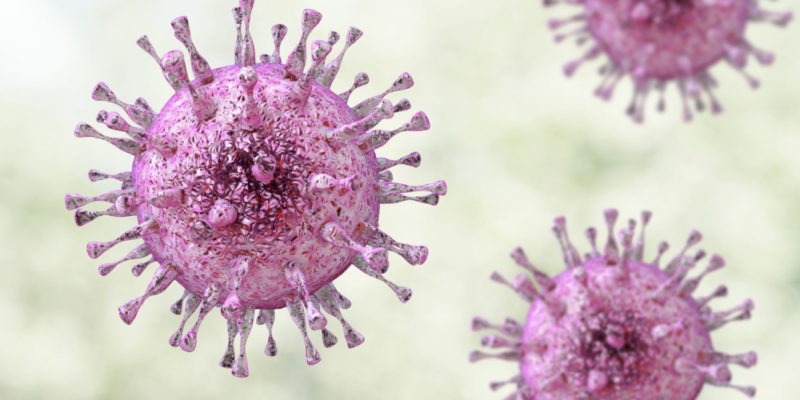Studies show that most people on the planet are carriers of deadly viruses, without even knowing about it. One of the infectious agents of this type - cytomegalovirus, was discovered relatively recently, only fifty years ago. It turned out that after penetration into the body, viral particles are not activated immediately, but only when certain conditions appear. In the tissues of a healthy person, cytomegalovirus is able to maintain a latent state for many years, waiting for the right moment to enter the cell.
It is difficult to avoid infection; it is still impossible to cure. The only thing that can be done is to learn to prevent the development of diseases caused by cytomegalovirus agents.
Material Content:
What is cytomegalovirus?
Cytomegaloviruses (CMV) - infectious agents, representatives of the group of human herpes viruses of the fifth type, pathogens of cytomegaly. CMV virions are recognized not only as the largest among other types of viruses, but also as one of the oldest - archaeological finds confirm the existence of these pathogens back in the Cambrian era.
For hundreds of thousands of years of existence, the herpetic virus was transmitted from person to person in the family circle, so infection usually occurred in early childhood.
Scientists have previously found in the tissues of the studied remains of cells affected by an unknown pathogen.But what is it, the researchers were able to find out much later - in the second half of the XX century.
A characteristic feature of the cytomegalovirus is the presence of a genome - double-stranded DNA, capable of producing 230 proteins that support the virion's vitality, its further development and reproduction.
In the body of a healthy person, virions are in a latent, inert state. Active synthesis of virus proteins occurs after its introduction into the host cells, which is possible against the background of a decrease in immunity.
As the pathogenic particles multiply, cytomegalovirus infection develops. Moreover, the acute form of CMV affects absolutely all types of cells in the human body, including brain cells.
The virus is especially dangerous for people with immunodeficiency and for newborns, because the complications caused by it can be incompatible with life.
How is the virus transmitted?
Transmission of cytomegalovirus is possible only in direct contact with the infection. A huge number of pathogenic particles are found in human physiological media - saliva, blood, sperm, urine, feces, tears, and breast milk.
Therefore, infection with a viral infectious disease is possible by any of the following methods:
- airborne droplets - at the time of sneezing, coughing or talking to an infected person, as well as with a kiss;
- during sexual intercourse - the pathogen may be in semen or in the tissues of the vaginal mucosa;
- with blood transfusion, if donor blood is received from an infected person;
- during organ transplantation of an infected donor;
- during pregnancy or during childbirth;
- with breastfeeding.
Most people become infected at preschool age - in kindergarten, during contacts with other children.
If infection has occurred, the virus remains in the human body forever. Statistics show that in developed countries around 80% of the population is infected with cytomegalovirus. The pathogen affects people of any age and skillfully disguises itself, so it is not always possible to detect it at the stage of a latent state.
Infection during pregnancy
Cytomegalovirus infection during pregnancy is considered especially dangerous, since there is a risk of infection of the fetus. According to statistics, congenital infections of children are observed in 50% of cases of primary infection of a pregnant woman, because maternal immunity is able to provide only partial protection for the child.
Virus activity is one of the main causes of spontaneous abortion, the development of severe fetal health problems, and premature birth.
As a result of the defeat of the cytomegalovirus, an anti-inflammatory immune reaction occurs and a delay in the proper development of fetal cells occurs. The earlier the infection occurred, the stronger the severity of pathological changes - hypoxia, systemic inflammation, malformations.
The first signs of CMV can be determined using ultrasound. In such cases, doctors recommend abortion, since there is practically no chance of having and having a healthy baby after infection with cytomegalovirus.
About 4% of babies are born dead or die soon after birth. More than 60% of children born are diagnosed with many progressive diseases.
Cytomegalovirus in children
Intrauterine infection of the fetus CMV after birth continues to progress.
Congenital cytomegaly causes a delay in the development of the child and leads to prematurity and the appearance of many diseases:
- protracted jaundice;
- dysfunctions of the nervous system;
- hepatosplenomegaly;
- thrombocytopenic purpura;
- pneumonia;
- hydrocephalus;
- DIC syndrome.
Such children are characterized by muscle weakness, insufficient weight, and mental retardation.In some cases, an asymptomatic course of congenital cytomegalovirus in children with the subsequent occurrence of sensorineural hearing loss is possible.
Virus forms
The causative agent of cytomegalovirus infection can be in the human body in various morphological forms.
Until the introduction of CMV into the cell, the CMV is in the form of a virion - a viral particle coated with a capsid membrane. At this stage, the virus does not show any activity, however, in the presence of favorable circumstances, the agent discards the membrane and enters the cell.
After capturing the cell, the virus invades the cell nucleus and subjugates it by integrating its DNA. The membrane of the nucleus becomes a platform for the formation of new virions. The cells infected with the virus significantly increase in size, so the causative agent of the infection is called cytomegalovirus - “megalo” in Greek means “large”.
If there is no possibility for development, the virus freezes and passes into a latent form. In this state, viral agents are practically unable to cause pronounced pathological changes in the health of their carrier.
Nevertheless, it has been scientifically proven that the very presence of viral particles in the body can cause chronic inflammatory processes and immune dysfunctions.
Most often, the virus is localized in the tissues of the salivary glands.
Symptoms and development of the disease
In most cases, the latent form of the cytomegalovirus in the human body does not show any signs. The presence of a viral lesion can only be said after the appearance of signs of an acute form of the disease caused by the agent.
The primary symptoms of acute cytomegalovirus can be expressed in the manifestations characteristic of acute respiratory viral infections - sore throat, fever, decreased appetite, general weakness and headaches.
Often, general symptoms are accompanied by increased salivation, characteristic of CMV.
Clinical forms of cytomegalovirus infection
The defeat of a cytomegalovirus infection leads to the emergence of diseases such as infectious mononucleosis, retinitis, colitis, pneumonitis, esophagitis, encephalitis, hepatitis, an increase in internal organs, and inflammation of the salivary glands.
In this case, congenital CMVI can occur in acute or chronic form. And the acquired infection of the cytomegalovirus usually proceeds in a latent form and only upon activation of the viral agent acquires an acute mononucleoside or generalized form.
Accordingly, the process of the development of diseases occurs:
- the acute form of a congenital infection is accompanied by pronounced signs of intoxication, bleeding of tissues and mucous membranes, an increase in the liver and spleen, inhibition of reflexes;
- the chronic form of a congenital infection is characterized by the development of microcephaly, hepatitis, passing into cirrhosis, as well as pneumosclerosis and fibrosis of lung tissue;
- the latent form of the acquired infection proceeds without severe symptoms;
- the acute mononucleosis-like form of the acquired type of infection is characterized by the intensity of the course - a sharp rise in temperature, pronounced signs of intoxication, an increase in the liver, the appearance of symptoms characteristic of acute respiratory viral infections;
- the generalized form of acquired infection is manifested by fever, swollen lymph nodes, rash, joint pain, coughing and shortness of breath. It affects the liver, kidneys and nervous system. It causes the development of pneumonia of a protracted nature. This form of the course of infection is the most complex. More common in children.
And it is also possible associative course of cytomegalovirus infection with other viral or bacterial diseases.
Diagnostic measures
Cytomegaly is difficult to diagnose. In women, latent forms of infection are detected against the background of miscarriage. In other cases, CMV latency is suspected when antibodies appear in the blood test.
The production of immunoglobulins is the body's natural defensive response to viral invasion. Specific antibodies to the cytomegalovirus Igg and Igm prevent the transition of infection into an acute form and are a marker for diagnostic findings.
The quantitative characteristics of antibodies can not only detect infection, but also determine the stage of infection
IgM - class M immunoglobulins indicate the presence of a current infection, which is possible in two cases - during the initial infection or when the latent form becomes acute. With such results of a blood test, pregnancy is contraindicated, doctors warn women about the possibility of intrauterine infection.
The decline in the quantitative characteristics of IgM suggests that the acute phase has subsided. A negative IgM test result may indicate that more than a month has passed since the infection.
IgG - immunoglobulins of class G, can be regarded as a sign of a latent course of the infection or its primary exacerbation, if the antibody readings exceed the norm. IgG antibodies have the ability to evolve in response to changes in the behavior of the pathogen. Therefore, doctors use the avidity of IgG to determine the duration of the primary infection.
If the test for cytomegalovirus IgG is positive, then more than a month has passed since the infection. A negative result of the analysis indicates a lower quantitative characteristics of IgG. For women, this may be a sign of an increased risk of infection, including during pregnancy.
Laboratory methods for the diagnosis of CMV
Along with a blood test, other methods are used to detect cytomegalovirus.
Among the most effective diagnostic measures:
- polymerase chain reaction - allows you to determine the DNA of the pathogen in the physiological environment of the patient. The accuracy of the method is 95%;
- seeding - a method that involves placing the test materials in a favorable environment. The accuracy of the method is 95%;
- cytological studies - determination of enlarged cells with intranuclear inclusions.
Additionally, other modern diagnostic methods can be applied - immunoblotting, radioimmunological analysis.
Disease treatment
At the moment, there are no reliable therapeutic methods for eliminating CMVI. In most cases, the treatment of cytomegalovirus is based on a complex pathogenetic effect that suppresses or reduces the severity of symptoms.
Traditional therapeutic measures are aimed at strengthening the patient's immune system. The main goal of therapy is to stop exacerbation and reduce the activity of viral particles. For this, antiviral drugs, antibiotics, medicines for herpes and general restorative drugs are used.
Forecast and Prevention
For a healthy person, cytomegalovirus is not dangerous, therefore, the prognosis for infection in this case is favorable.
The activity of the virus can threaten the health and life of a person with a decrease in immunity. The prognosis of the disease is unfavorable for patients with immunodeficiency, as well as for children with congenital infection.
Preventive measures minimize the possibility of infection or exacerbation of CMV.
To avoid diseases associated with cytomegalovirus, it is necessary:
- observe personal hygiene, be sure to wash your hands with soap and water before preparing meals and eating, after going to the toilet or changing a diaper;
- never use other people's personal things - toothbrushes, cutlery, toys;
- apply gloves in contact with biological fluids - blood, sperm, saliva, urine;
- give up bad habits, ensure a healthy and nutritious diet and lead an active lifestyle - these rules can not only strengthen immunity, but also maintain its potential.
Active searches are underway for a vaccine against CMV.Perhaps in the near future, medicine will be able to defeat a dangerous virus and one less threat to human health on the planet will be less.























